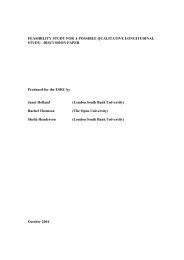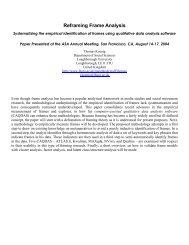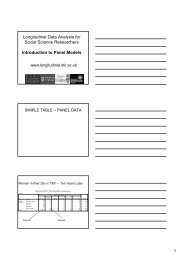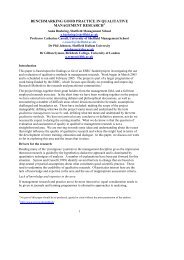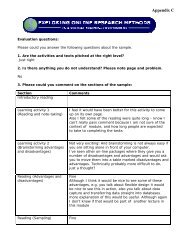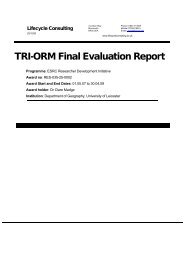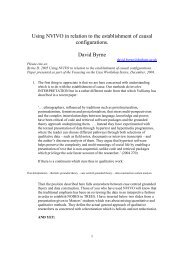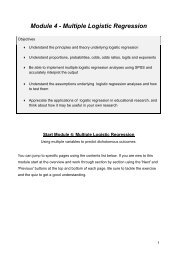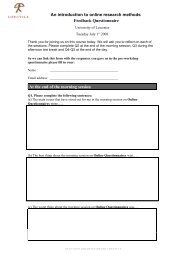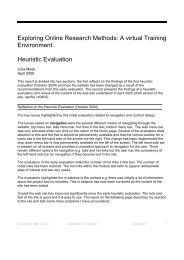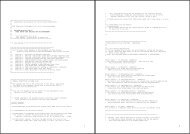David Bell Introduction to Stata
David Bell Introduction to Stata
David Bell Introduction to Stata
Create successful ePaper yourself
Turn your PDF publications into a flip-book with our unique Google optimized e-Paper software.
<strong>Introduction</strong><br />
<strong>to</strong> <strong>Stata</strong><br />
<strong>Introduction</strong> <strong>to</strong> <strong>Stata</strong><br />
<strong>David</strong> <strong>Bell</strong><br />
Department of Economics<br />
University of Stirling<br />
<strong>Introduction</strong> <strong>to</strong> <strong>Stata</strong> by <strong>David</strong> <strong>Bell</strong> 1
<strong>Introduction</strong><br />
<strong>to</strong> <strong>Stata</strong><br />
The <strong>Stata</strong> Interface<br />
Menus<br />
Review<br />
Results<br />
Variables<br />
Commands<br />
<strong>Introduction</strong> <strong>to</strong> <strong>Stata</strong> by <strong>David</strong> <strong>Bell</strong> 2
<strong>Introduction</strong><br />
<strong>to</strong> <strong>Stata</strong><br />
What can<br />
<strong>Stata</strong> do?<br />
<strong>Introduction</strong> <strong>to</strong> <strong>Stata</strong> by <strong>David</strong> <strong>Bell</strong> 3
<strong>Introduction</strong><br />
<strong>to</strong> <strong>Stata</strong><br />
What can<br />
<strong>Stata</strong> do?<br />
<strong>Introduction</strong> <strong>to</strong> <strong>Stata</strong> by <strong>David</strong> <strong>Bell</strong> 4
<strong>Introduction</strong><br />
<strong>to</strong> <strong>Stata</strong><br />
What can<br />
<strong>Stata</strong> do?<br />
<strong>Introduction</strong> <strong>to</strong> <strong>Stata</strong> by <strong>David</strong> <strong>Bell</strong> 5
<strong>Introduction</strong><br />
<strong>to</strong> <strong>Stata</strong><br />
What can<br />
<strong>Stata</strong> do?<br />
<strong>Introduction</strong> <strong>to</strong> <strong>Stata</strong> by <strong>David</strong> <strong>Bell</strong> 6
<strong>Introduction</strong><br />
<strong>to</strong> <strong>Stata</strong><br />
What can<br />
<strong>Stata</strong> do?<br />
<strong>Introduction</strong> <strong>to</strong> <strong>Stata</strong> by <strong>David</strong> <strong>Bell</strong> 7
<strong>Introduction</strong><br />
<strong>to</strong> <strong>Stata</strong><br />
• Known commands<br />
Getting Help<br />
help tabulate from the Viewer command line:<br />
• You need not know the command name. Get<br />
information about nonparametric tests:<br />
search nonparametric from the Viewer<br />
command line<br />
• To search <strong>Stata</strong> and the net for information on<br />
goodness-of-fit tests with panel estima<strong>to</strong>rs:<br />
findit panel goodness<br />
<strong>Introduction</strong> <strong>to</strong> <strong>Stata</strong> by <strong>David</strong> <strong>Bell</strong> 8
<strong>Introduction</strong><br />
<strong>to</strong> <strong>Stata</strong><br />
Files in <strong>Stata</strong><br />
• .dta - <strong>Stata</strong> dataset<br />
• .ado - <strong>Stata</strong> program<br />
• .do – <strong>Stata</strong> command file<br />
• .smcl, .log – <strong>Stata</strong> output files<br />
• .gph – <strong>Stata</strong> graph file<br />
• Note also that <strong>Stata</strong> can read and write<br />
from/<strong>to</strong> .csv files (spreadsheets)<br />
<strong>Introduction</strong> <strong>to</strong> <strong>Stata</strong> by <strong>David</strong> <strong>Bell</strong> 9
<strong>Introduction</strong><br />
<strong>to</strong> <strong>Stata</strong><br />
do and ado files<br />
• do se<strong>to</strong>fcommands.do<br />
– executes a set of commands s<strong>to</strong>red in the<br />
text file se<strong>to</strong>fcommands.do<br />
• program<br />
– executes the program s<strong>to</strong>red in the text file<br />
program.ado<br />
– almost all <strong>Stata</strong> commands are themselves<br />
ado files<br />
– this structure contributes hugely <strong>to</strong> the<br />
extensibility of <strong>Stata</strong><br />
– update regularly <strong>to</strong> get the most recent<br />
versions of ado files and executables<br />
<strong>Introduction</strong> <strong>to</strong> <strong>Stata</strong> by <strong>David</strong> <strong>Bell</strong> 10
<strong>Introduction</strong><br />
<strong>to</strong> <strong>Stata</strong><br />
log and smcl files<br />
• Results are immediately available in the<br />
results window and can be copied and pasted<br />
in<strong>to</strong> a spreadsheet<br />
• log and smcl files are used when a lot of<br />
output material is being generated<br />
– log using mylog - opens smcl file<br />
– log using mylog.log – opens log (text) file<br />
– log using mylog, replace -<br />
• replaces previous version of mylog<br />
– log using mylog, append<br />
• appends <strong>to</strong> previous version of mylog<br />
– log close<br />
– pause/restart logs using log on and log off<br />
<strong>Introduction</strong> <strong>to</strong> <strong>Stata</strong> by <strong>David</strong> <strong>Bell</strong> 11
<strong>Introduction</strong><br />
<strong>to</strong> <strong>Stata</strong><br />
Starting Point: A<br />
Rectangular Dataset<br />
N Observations<br />
⎛<br />
⎜<br />
⎜<br />
x x ... x<br />
11 12 1K<br />
x x ... x<br />
21 22 2K<br />
⎞<br />
⎟<br />
⎟<br />
⎜<br />
... ... ... ...<br />
⎟<br />
⎜<br />
⎟<br />
⎝<br />
x x ... x<br />
N1 N 2<br />
NK<br />
⎠<br />
K Variables<br />
<strong>Introduction</strong> <strong>to</strong> <strong>Stata</strong> by <strong>David</strong> <strong>Bell</strong> 12
<strong>Introduction</strong><br />
<strong>to</strong> <strong>Stata</strong><br />
Loading dataset,<br />
saving, clearing<br />
Allocate memory <strong>to</strong> <strong>Stata</strong> dataset<br />
• set mem 100m<br />
Load <strong>Stata</strong>-format dataset<br />
• use [varlist] [if] [in] using filename [, clear nolabel]<br />
Save data in memory <strong>to</strong> file<br />
• save [filename] [, save_options]<br />
Clearing dataset from memory<br />
• clear<br />
<strong>Introduction</strong> <strong>to</strong> <strong>Stata</strong> by <strong>David</strong> <strong>Bell</strong> 13
<strong>Introduction</strong><br />
<strong>to</strong> <strong>Stata</strong><br />
Variable Names<br />
• Variable names can be 1-32 characters, but <strong>Stata</strong> often<br />
abbreviates long variable names in output<br />
• The letters a-z, the numbers 0-9 and _ (underscore)<br />
are valid characters.<br />
• Names must start with a letter (or an underscore, but<br />
because many <strong>Stata</strong>-generated variables also start with<br />
an underscore).<br />
• These are valid variable names: q17 q_17 pregnant sex<br />
<strong>Stata</strong> is case-sensitive!<br />
• Variable names may include lowercase and uppercase<br />
letters, but <strong>Stata</strong> is case-sensitive: sex and Sex are<br />
two different variable names. Best stick <strong>to</strong> lowercase.<br />
<strong>Introduction</strong> <strong>to</strong> <strong>Stata</strong> by <strong>David</strong> <strong>Bell</strong> 14
<strong>Introduction</strong><br />
<strong>to</strong> <strong>Stata</strong><br />
Numeric Types<br />
• Most often you don't need worry about numeric types,<br />
but they can be relevant, particularly if you run out of<br />
memory. Standard types are:<br />
Type Bytes Precision (digits) Range (approx.)<br />
Integer byte 1 2 ±100<br />
int 2 4 ±32,000<br />
long 4 9 ±2×109<br />
Floating point<br />
float 4 7 ±1036<br />
double 8 16 ±10308<br />
• Sometimes your data will be in string format and you<br />
will have <strong>to</strong> use the encode command <strong>to</strong> convert it <strong>to</strong><br />
numeric<br />
• compress can reduce the size of your dataset<br />
considerably by finding the most economical way of<br />
s<strong>to</strong>rage.<br />
<strong>Introduction</strong> <strong>to</strong> <strong>Stata</strong> by <strong>David</strong> <strong>Bell</strong> 15
<strong>Introduction</strong><br />
<strong>to</strong> <strong>Stata</strong><br />
<strong>Stata</strong> command syntax<br />
[prefix :] command [varlist] [=exp] [if] [in] [weight]<br />
[using filename] [, options]<br />
[ ] implies that the enclosed arguments are optional<br />
The weight option requires square brackets<br />
A varlist is a list of variable names with blanks in<br />
between. There are a number of shorthand conventions<br />
<strong>to</strong> reduce the amount of typing. e.g.<br />
myvar<br />
just one variable<br />
myvar thisvar thatvar three variables<br />
myvar*<br />
variables starting with myvar<br />
*var<br />
variables ending with var<br />
my1-my4<br />
my1, my2, my3 and my4<br />
<strong>Introduction</strong> <strong>to</strong> <strong>Stata</strong> by <strong>David</strong> <strong>Bell</strong> 16
<strong>Introduction</strong><br />
<strong>to</strong> <strong>Stata</strong><br />
if<br />
Syntax:<br />
• command if exp<br />
• exp in the syntax diagram means an<br />
expression<br />
Examples:<br />
• list make mpg if mpg>25<br />
• list make mpg if mpg>25 & mpg25 | mpg
<strong>Introduction</strong><br />
<strong>to</strong> <strong>Stata</strong><br />
Relational expressions<br />
(used in if expressions)<br />
== - is equal <strong>to</strong><br />
- is greater than<br />
>= - is greater than of equal <strong>to</strong><br />
~= - is not equal <strong>to</strong><br />
& - logical and<br />
| - logical or<br />
<strong>Introduction</strong> <strong>to</strong> <strong>Stata</strong> by <strong>David</strong> <strong>Bell</strong> 18
<strong>Introduction</strong><br />
<strong>to</strong> <strong>Stata</strong><br />
in<br />
Syntax:<br />
• command in range<br />
• Range in the expression means a range of<br />
observations<br />
Examples:<br />
• list in 10<br />
• list in 10/20<br />
• list in 20/l (lowercase l at end of range)<br />
• list in 1/10 (numeric 1 in beginning of range)<br />
<strong>Introduction</strong> <strong>to</strong> <strong>Stata</strong> by <strong>David</strong> <strong>Bell</strong> 19
<strong>Introduction</strong><br />
<strong>to</strong> <strong>Stata</strong><br />
weight<br />
Most <strong>Stata</strong> commands can deal with weighted data.<br />
<strong>Stata</strong> allows four kinds of weights:<br />
• fweights, or frequency weights indicate the number of<br />
duplicated observations.<br />
• pweights, or sampling weights denote the inverse of the<br />
probability that the observation is included due <strong>to</strong> the<br />
sampling design.<br />
• aweights, or analytic weights, are inversely proportional<br />
<strong>to</strong> the variance of an observation; i.e., the variance of<br />
the j-th observation is assumed <strong>to</strong> be sigma^2/w_j,<br />
where w_j are the weights. Typically, the observations<br />
represent averages and the weights are the number of<br />
elements that gave rise <strong>to</strong> the average.<br />
• iweights, or importance weights, are weights that<br />
indicate the "importance" of the observation in some<br />
vague sense.<br />
<strong>Introduction</strong> <strong>to</strong> <strong>Stata</strong> by <strong>David</strong> <strong>Bell</strong> 20
<strong>Introduction</strong><br />
<strong>to</strong> <strong>Stata</strong><br />
numlist<br />
Some commands also require a numlist. This<br />
is sometimes shown in syntax diagrams as<br />
#list. is a list of numbers with blanks or<br />
commas in between. Conventions <strong>to</strong> reduce<br />
their size include:<br />
1/3 three numbers, 1, 2, 3<br />
3/1 the same three numbers in<br />
reverse order<br />
1 6 8/12 seven numbers 1 6 8 9 10 11 12<br />
1 2 <strong>to</strong> 4 four numbers, 1, 2, 3, 4<br />
1(2)9 five numbers, 1, 3, 5, 7, 9<br />
<strong>Introduction</strong> <strong>to</strong> <strong>Stata</strong> by <strong>David</strong> <strong>Bell</strong> 21
<strong>Introduction</strong><br />
<strong>to</strong> <strong>Stata</strong><br />
Describing the dataset<br />
<strong>Introduction</strong> <strong>to</strong> <strong>Stata</strong> by <strong>David</strong> <strong>Bell</strong> 22
<strong>Introduction</strong><br />
<strong>to</strong> <strong>Stata</strong><br />
Editing the dataset<br />
Command is<br />
edit<br />
or<br />
Window<br />
Data edi<strong>to</strong>r<br />
Dataset is<br />
the LFS<br />
<strong>Introduction</strong> <strong>to</strong> <strong>Stata</strong> by <strong>David</strong> <strong>Bell</strong> 23
<strong>Introduction</strong><br />
<strong>to</strong> <strong>Stata</strong><br />
Describing variables<br />
Describe data in memory or in file<br />
• describe [varlist] [,describe_m_options]<br />
Note: commands can be shortened <strong>to</strong> the<br />
underlined letters<br />
Examples:<br />
• des party_member<br />
• des party_member, det<br />
• des party_member, nol<br />
<strong>Introduction</strong> <strong>to</strong> <strong>Stata</strong> by <strong>David</strong> <strong>Bell</strong> 24
<strong>Introduction</strong><br />
<strong>to</strong> <strong>Stata</strong><br />
Tabulating data<br />
Creating one-way and two-way tables<br />
• tabulate varname [if] [in] [weight] [, tabulate1_options]<br />
• tabulate varname1 varname2 [if] [in] [weight] [, options]<br />
Example: one-way tables<br />
• tabulate foreign<br />
• tabulate region [aweight=pop]<br />
Example: two-way tables<br />
• tabulate foreign rep78<br />
• tabulate region citysize [aweight=pop]<br />
<strong>Introduction</strong> <strong>to</strong> <strong>Stata</strong> by <strong>David</strong> <strong>Bell</strong> 25
<strong>Introduction</strong><br />
<strong>to</strong> <strong>Stata</strong><br />
Tabulate option: summarize<br />
Report summary statistics for one<br />
variable using the categories of another<br />
Example: one-way tables<br />
• tabulate foreign, summarize(mpg)<br />
• tabulate region [aweight=pop],<br />
summarize(age)<br />
Example: two-way tables<br />
• tabulate foreign rep78, sum(mpg)<br />
• tabulate region citysize [aw=pop], sum(age)<br />
<strong>Introduction</strong> <strong>to</strong> <strong>Stata</strong> by <strong>David</strong> <strong>Bell</strong> 26
<strong>Introduction</strong><br />
<strong>to</strong> <strong>Stata</strong><br />
Control tabular output<br />
with tab options<br />
Show percentages by column<br />
• tabulate foreign rep78, col<br />
Show percentages by cell<br />
• tabulate region citysize [aw=pop], cell<br />
Show percentages by row and do not<br />
show frequencies<br />
• tab region citysize, row nofreq<br />
<strong>Introduction</strong> <strong>to</strong> <strong>Stata</strong> by <strong>David</strong> <strong>Bell</strong> 27
<strong>Introduction</strong><br />
<strong>to</strong> <strong>Stata</strong><br />
Prefix option: by<br />
by makes a command operate on subgroups of<br />
the data. Data must be pre-sorted e.g.<br />
sort sex<br />
by sex: summarize age height weight<br />
or, in one line:<br />
bysort sex: summarize age height weight<br />
<strong>Introduction</strong> <strong>to</strong> <strong>Stata</strong> by <strong>David</strong> <strong>Bell</strong> 28
Create or change contents<br />
<strong>Introduction</strong><br />
<strong>to</strong> <strong>Stata</strong><br />
of variable<br />
Create new variable<br />
• generate [type] newvar[:lblname] =exp [if]<br />
[in]<br />
Change contents of existing variable<br />
• replace oldvar =exp [if] [in] [,nopromote]<br />
gen agesq = age^2<br />
replace tenure = tenure + 4 if age < 42<br />
<strong>Introduction</strong> <strong>to</strong> <strong>Stata</strong> by <strong>David</strong> <strong>Bell</strong> 29
<strong>Introduction</strong><br />
<strong>to</strong> <strong>Stata</strong><br />
Functions <strong>to</strong> use with<br />
generate, replace<br />
• man function<br />
• gen p = min(y)<br />
• gen f = normal(z)<br />
<strong>Introduction</strong> <strong>to</strong> <strong>Stata</strong> by <strong>David</strong> <strong>Bell</strong> 30
<strong>Introduction</strong><br />
<strong>to</strong> <strong>Stata</strong><br />
Generating dummy<br />
variables with tabulate<br />
• One-way tabulate with gen option<br />
• e.g. tab sex, gen(gender)<br />
Produces indica<strong>to</strong>r (dummy) variables<br />
for each category of sex. These will be<br />
named gender1 and gender2<br />
<strong>Introduction</strong> <strong>to</strong> <strong>Stata</strong> by <strong>David</strong> <strong>Bell</strong> 31
<strong>Introduction</strong><br />
<strong>to</strong> <strong>Stata</strong><br />
Recoding data<br />
• recode changes the values of a variable – <strong>to</strong><br />
produce new groupings or <strong>to</strong> transform a<br />
continuous variable in<strong>to</strong> dummy variables.<br />
recode age (55/max=3)(15/55=2)(min/15=1) ,<br />
gen(agegr)<br />
• Value labels for the new variable may be<br />
included at once:<br />
recode age (55/max=3 "55+")(15/55=3 “15-54") ///<br />
– (min/15=1 “0-14") , gen(agegr)<br />
• The generate option creates a new recoded variable;<br />
without generate the original information in age will be<br />
destroyed.<br />
<strong>Introduction</strong> <strong>to</strong> <strong>Stata</strong> by <strong>David</strong> <strong>Bell</strong> 32
<strong>Introduction</strong><br />
<strong>to</strong> <strong>Stata</strong><br />
Missing Values<br />
• Missing values are omitted from calculations.<br />
• The system missing value is shown as a .<br />
(period). It is created in input when a numeric<br />
field is empty; by invalid calculations, e.g.<br />
division by 0, or calculations involving a<br />
missing value.<br />
• Unfortunately no data entry program accepts .<br />
in a numeric field. You might choose the code<br />
-9 and ask <strong>Stata</strong> <strong>to</strong> recode them:<br />
• recode _all (-9=.)<br />
• Missing values are large positive numbers –<br />
this is very important for calculating<br />
conditions.<br />
<strong>Introduction</strong> <strong>to</strong> <strong>Stata</strong> by <strong>David</strong> <strong>Bell</strong> 33
<strong>Introduction</strong><br />
<strong>to</strong> <strong>Stata</strong><br />
Regression<br />
• regress depvar [indepvars] [if] [in]<br />
[weight] [, options]<br />
• Options<br />
– noconstant<br />
– robust<br />
– cluster(var)<br />
<strong>Introduction</strong> <strong>to</strong> <strong>Stata</strong> by <strong>David</strong> <strong>Bell</strong> 34
<strong>Introduction</strong><br />
<strong>to</strong> <strong>Stata</strong><br />
More Regression Commands<br />
<strong>Introduction</strong> <strong>to</strong> <strong>Stata</strong> by <strong>David</strong> <strong>Bell</strong> 35
<strong>Introduction</strong><br />
<strong>to</strong> <strong>Stata</strong><br />
Even More<br />
Regression Commands!<br />
<strong>Introduction</strong> <strong>to</strong> <strong>Stata</strong> by <strong>David</strong> <strong>Bell</strong> 36
<strong>Introduction</strong><br />
<strong>to</strong> <strong>Stata</strong><br />
And so <strong>to</strong> panel data …<br />
<strong>Introduction</strong> <strong>to</strong> <strong>Stata</strong> by <strong>David</strong> <strong>Bell</strong> 37



